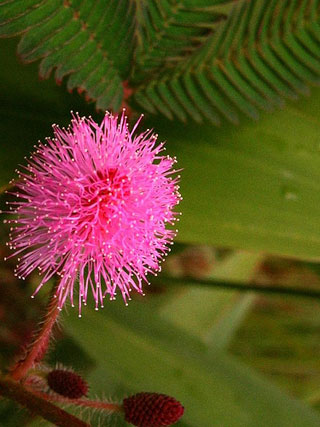Human Flower Project
Sunday, August 27, 2006
Makahiya— Shy Heroine of the Philippines
A blossom newly named for President Arroyo sets off fury in a land of flower legends.

Makahiya: “Sensitive plant”
Photo: Maverick
Maybe because its countryside is so very lush, Philippine Island culture abounds with creation myths, legends that “remind us of our connection to nature. We have a lot of stories on the origins of flowers, like those of dama de noche, roses, ilang-ilang, sampaguita…” writes Norma Dollaga. “Listening to these stories, we are able to connect ourselves spiritually and ecologically with the gift of creation.”
Dollaga writes that, as in the rest of the world, “Most of these ‘alamat’ [myths] we grew up with are stories on the goodness or evil ways of people. Myths and legends remind us that when a person dies or disappears, an embodiment of that person will arise.”
If this sounds like mild-mannered folkloristics, think again. Dollaga’s op-ed piece for INQ7 is as pointed as pitchfork—she’s fuming that a flower has been named for Filipino president Gloria Macapagal-Arroyo. “Mussaenda Gloria Macapagal Arroyo,” honoring the controversial head of state, was bred by Dr. Teresita Rosario. “It fits the President. It is petite and cute,” Rosario said.
With the Islands’ old custom of turning flower legend into object lesson, how, Dollaga asks, “can a leader widely perceived as corrupt, fraudulent and a cheat be cute? Naming a flower after Ms Arroyo is a betrayal of the people and dishonors flowers. Flowers must be adored and respected. Dr. Rosario’s flower deserves better.”
 Seed packet for Mimosa pudica
Seed packet for Mimosa pudica
Source: Amaday
Dollaga then tells the story of Makahiya or “sensitive plant.” Once upon a similarly-corrupt time, bandits roamed the land. In one village lived a humble family, mother, father and their shy, virtuous girl, Maria. Eventually the band of thieves arrived and plundered their town, knocking the parents unconscious. When they awoke they looked for their precious daughter only to find Mimosa pudica, an odd new plant with firecracker-like blossoms. When touched, the plant drew its leaves together, as if to hide. They resolved that their dear and pure Maria had changed into this sensitive plant rather than surrender her virtue.
(The Makahiya story sounds a lot like the Greek myth of Daphne; she escaped the clutches of Apollo by turning into a laurel tree.)
With a bit of snooping, we’ve found a number of references to Makahiya, showing how dear this plant is to those who grew up in the Philippines. One young blogger writes, “I was five years old the last time I visited the Philippines, with my mom. Even though my memories of the trip are few, I do have one that has remained close to my heart: my mom showing me this magical plant called makahiya.
“This very small fern-like plant blossoms with numerous heads of pink and lavender flowers. When touched, as if by magic, the leaves close up onto themselves. My mother instructed me to touch this plant, and I remember very vividly seeing the leaves curl and close and giggling with glee as I ran around the garden looking for more. A few weeks ago, Tita Jo kindly invited me to her lovely little summer home in Antipollo (about one hour north of Quezon City). There in her garden she pointed out the makahiya plant. I again touched the leaves, and with just as much delight (if not more) I watched them curl and close up.”
Mimosa pudica is actually native to Brazil though it has spread over much of the tropics. Kinmatsu Lin posts several good photos and Maverick offers some etymological details. “Other names given to this curious plant are Humble plant, Shame plant, Sleeping grass, Touch-me-not, and Mori Vivi (West Indies). The Chinese name for this plant translates to ‘shyness grass.’ The species epithet, pudica, is Latin for ‘bashful’ or ‘shrinking.’”
And in Tagalog, the language of much of the Philippines, Makahiya means “shy”…certainly not the characteristic of a woman who would be president.
We share Norma Dollaga’s interest in legends and likewise think that the rampant naming of flowers for celebrities—whether shiny movie stars or shady politicians—slights our cultures and our flowers, too. At the same time, the feminist in us bristles. Why are these “female” plants of lore usually the shrinking, low-growing, delicate ones?
Ms. Dollaga, perhaps would you approve attaching “Gloria Macapagal Arroyo” to something tall, garish, prickly, or stinky?




